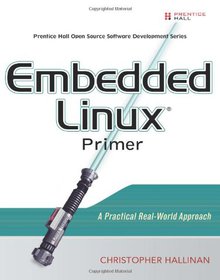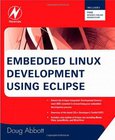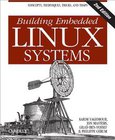Embedded Linux Primer
A Practical Real-World Approach

Book Details:
| Publisher: | Prentice Hall |
| Series: | Prentice Hall , Embedded |
| Author: | Christopher Hallinan |
| Edition: | 1 |
| ISBN-10: | 0131679848 |
| ISBN-13: | 9780131679849 |
| Pages: | 576 |
| Published: | Sep 28 2006 |
| Posted: | Nov 19 2014 |
| Language: | English |
| Book format: | CHM |
| Book size: | 3.37 MB |
Book Description:
Comprehensive Real-World Guidance for Every Embedded Developer and Engineer This book brings together indispensable knowledge for building efficient, high-value, Linux-based embedded products: information that has never been assembled in one place before. Drawing on years of experience as an embedded Linux consultant and field application engineer, Christopher Hallinan offers solutions for the specific technical issues you're most likely to face, demonstrates how to build an effective embedded Linux environment, and shows how to use it as productively as possible. Hallinan begins by touring a typical Linux-based embedded system, introducing key concepts and components, and calling attention to differences between Linux and traditional embedded environments. Writing from the embedded developer's viewpoint, he thoroughly addresses issues ranging from kernel building and initialization to bootloaders, device drivers to file systems. Hallinan thoroughly covers the increasingly popular BusyBox utilities; presents a step-by-step walkthrough of porting Linux to custom boards; and introduces real-time configuration via CONFIG_RT--one of today's most exciting developments in embedded Linux. You'll find especially detailed coverage of using development tools to analyze and debug embedded systems--including the art of kernel debugging. Compare leading embedded Linux processors Understand the details of the Linux kernel initialization process Learn about the special role of bootloaders in embedded Linux systems, with specific emphasis on U-Boot Use embedded Linux file systems, including JFFS2--with detailed guidelines for building Flash-resident file system images Understand the Memory Technology Devices subsystem for flash (and other) memory devices Master gdb, KGDB, and hardware JTAG debugging Learn many tips and techniques for debugging within the Linux kernel Maximize your productivity in cross-development environments Prepare your entire development environment, including TFTP, DHCP, and NFS target servers Configure, build, and initialize BusyBox to support your unique requirements About the Author Christopher Hallinan, field applications engineer at MontaVista software, has worked for more than 20 years in assignments ranging from engineering and engineering management to marketing and business development. He spent four years as an independent development consultant in the embedded Linux marketplace. His work has appeared in magazines, including Telecommunications Magazine, Fiber Optics Magazine, and Aviation Digest.
Download Link:
Related Books:
Embedded Linux
Hardware, Software, and Interfacing
Embedded Linux will help the user: select an Embedded Linux platform based on hardware requirements; build and boot a custom Linux kernel for the platform; remote debug programs running on the platform using GNU tools; connect data acquisition and control electronics/peripherals using the platform's serial, parallel, USB, I/O port and I2C interfaces; interface the peripherals to the kernel and applications using modules; collect, control, store and present data via open source protocols and applications; and analyze Embedded Linux vendor product offerings....
Embedded Linux Development Using Eclipse
The Eclipse environment solves the problem of having to maintain your own Integrated Development Environment (IDE), which is time consuming and costly. Embedded tools can also be easily integrated into Eclipse. The C/C++CDT is ideal for the embedded community with more than 70% of embedded developers using this language to write embedded code. Eclipse simplifies embedded system development and then eases its integration into larger platforms and frameworks. In this book, Doug Abbott examines Eclipse, an IDE, which can be vital in saving money and time in the design and development of an embedded system. Eclipse was created by IBM in 2001 and then became an open-source project in 2004. Since then it has become the de-facto IDE for embedded developers....
Building Embedded Linux Systems
2nd Edition
There's a great deal of excitement surrounding the use of Linux in embedded systems -- for everything from cell phones to car ABS systems and water-filtration plants -- but not a lot of practical information. Building Embedded Linux Systems offers an in-depth, hard-core guide to putting together embedded systems based on Linux. Updated for the latest version of the Linux kernel, this new edition gives you the basics of building embedded Linux systems, along with the configuration, setup, and use of more than 40 different open source and free software packages in common use. The book also looks at the strengths and weaknesses of using Linux in an embedd...
2007 - 2021 © eBooks-IT.org



